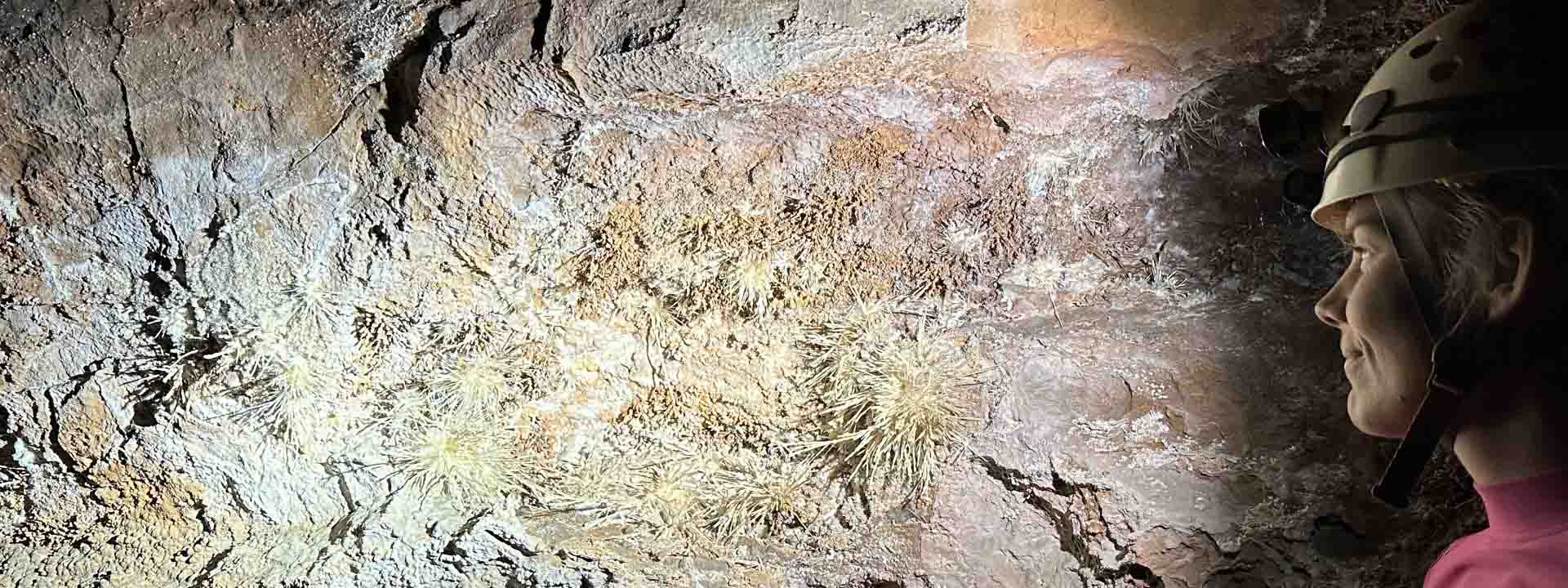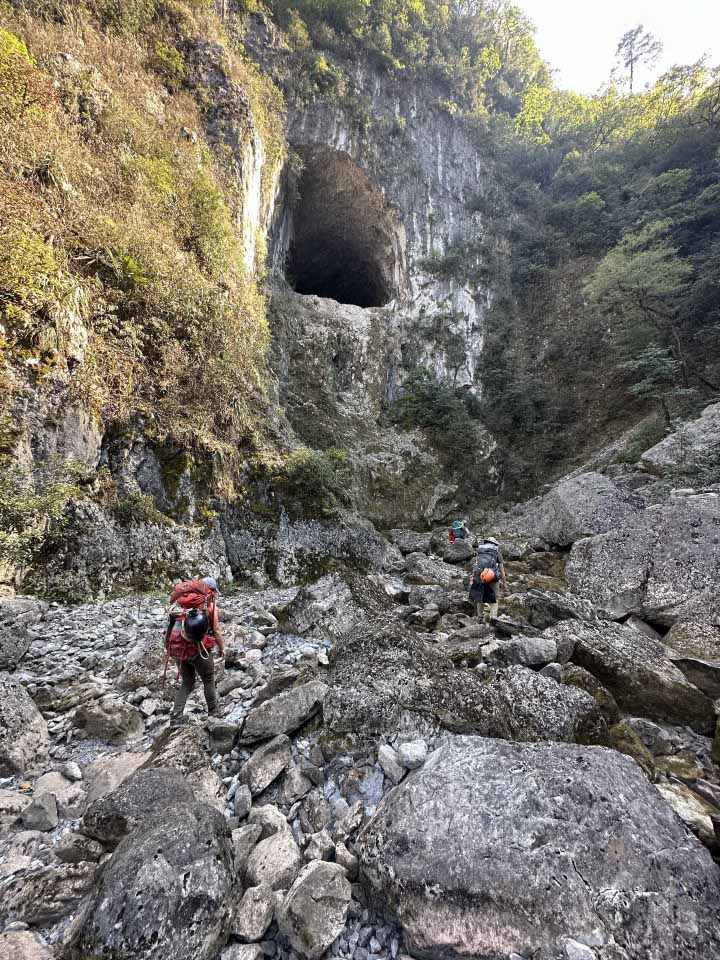Geology professor explores cave system in Mexico

Dr. Liana Boop is a geology professor at the North Campus and has been with the San Jacinto College family since August 2015. She has been cave exploring for 19 years, most recently in 2023.
Q: How did this expedition come to be, and why this particular location?
A: Exploration and mapping of this cave system has been active since the 1970s. As of 2022, the mapped length was 98,691 meters with a depth of 953 meters, making it one of the major systems in Mexico (but not the largest). Work is ongoing to connect various karst features in the area to understand the overall cave system. This includes exploration of horizontal and vertical cave passages above the water table, as well as exploration of flooded passages by cave divers.
Q: What inspired this adventure?
A: This was a personal trip to support the cave diving team and map previously unmapped passages within the cave. The objectives of the trip were two-fold. First, we had to transport dive gear for three divers to the dive site, which required hiking through the forest, hopping over boulders the size of cars in the stream, hauling the gear into the cave entrance, and delivering it to the sump that the divers would dive. Second, the team members who were not cave divers would spend the remainder of our time mapping above-water cave passages.
Q: Were there things you got to see and experience that the average person never would in their lifetime?
A: Ha! I Don’t even know where to start on this one. We were in the cave for seven nights. That is well outside the experience of an average person. While some members of the team did return to the surface for various reasons, most of the team did not. I didn’t realize how much the sun helped me to distinguish one day from the next. Although we ate three meals and got a “full night’s sleep” each night, it was difficult for me to feel the days pass. Other than that, it was sort of a standard camping trip: limited access to comforts (although I did bring in my one-pound hiking chair), limited access to personal hygiene, use of a trench latrine that got progressively smellier as the expedition progressed … I don’t think most people experience total darkness, which when all lights are off, is in abundance in a cave. When we’re lying in bed, we can still see a bit from the moonlight or various appliance lights in our bedrooms. In a cave, none of that is available to help you find the outlines of nearby features.
 Q: What was the temperature like in there?
Q: What was the temperature like in there?
A: The temperature was stable and comfortable. It was slightly damp such that the clothes that I wore during the day became moist overnight; my body heat dried them when I wore them each day. I am almost always cold, so I brought extra layers that I didn’t end up using. I was comfortable in spandex shorts and a polypro top. Unfortunately, my lightweight pants ripped on the first day!
My camping area was on a standard tarp. I brought my backpacking air mattress (Thermarest), my 35 F-rated sleeping bag, and a sleeping-bag liner that provides an additional 20 F of comfort. The tarp was large enough that I could have piles of various things within reach.
Q: Describe the biology/wildlife?
A: One of the project coordinators is a biologist, and he has ongoing projects in the cave. The divers reported seeing worms that he did not yet document. Small cave-adapted arthropods can be found from time to time, a distant from the entrance. A variety of species (birds, bats, insects, plants, etc.) can be found in the entrance area where sunlight permeates; bats can be found in more distant locations of the cave. One area had desiccated bats, possibly because they got trapped by flooding water or a passage collapse. These are sort of special because the passage is uncharacteristically dry and prevented decay.
Q: What type of gear did you need?
A: I used vertical caving gear to climb rope, a helmet, kneepads, survey equipment, and a variety of camping gear. The cave divers had a variety of equipment that I am unfamiliar with. We used a drill to power the Tyrolean traverse to haul gear up to the cave entrance.
Q: Tell us about the smells and sounds of such a place.
A: Both are minimal! The cave floods every year, which is one reason that we are able to bury our organic waste—the cave is inundated for months on end, so this helps to erase our impact. The latrine area was in a separate passage to the side of the main camping area, so we did not smell that unless we were doing our personal business in that area. All drinking water was treated with Microdyne, which gave us all some weird dreams! Sounds included the typical drips from speleothems as well as gurgles from water rising or falling in distant cave passages.
Q: What inspired you to choose this career path?
A: In high school, I knew that I loved the sciences, but it wasn’t until my first geology class in college that I was hooked. I went on a field trip to a cave, and I remember sitting on a fault and having an awareness that I was within a textbook diagram. Most people will never be able to have such a perspective. The wall above me was a different rock type than the rock I was sitting on.
Q: Outside of your career hours, what do you do for fun, hobbies, activities, interests, etc.?
A: Nowadays I do a lot of hiking — it’s easier than caving. Expeditions like this one take a tremendous investment of time — one that is in short supply when school is in session. I enjoy being active and can be found walking or running the White Oak and Buffalo Bayou trails or spending time on my bike.
Q: Is there a book you think others should read, and why?
A: I carried John McPhee’s “The Survival of the Bark Canoe” into the cave with me because it was a thin paperback; John McPhee and Simon Winchester are my two favorite authors about natural topics and geology. John McPhees “Annals of the Former World” is a fantastic read about North America’s geology, but it’s not particularly relevant to caving.
Q: What is something that automatically puts you in a good mood?
A: Nature, seclusion, my two cats, a good meal, and/or my Spice Girls Pandora Station are all good bets. 😉
Q: What do you hope someone will remember about you after meeting you for the first time?
A: I think good communication is critical for good relationships and for working on an expedition like this one and beyond. I don’t think that most people are in situations where they trust their lives to their team members, but on an expedition like this, everyone is aware of that. On this expedition, we had two National Cave Rescue Commission instructors — which meant that if anything went wrong, they would know exactly how to respond and lead the rest of the team. In my caving and hiking partners, I know that I’m trusting my life to them and they are doing the same for me—that’s not a responsibility I take lightly. If something goes wrong, speed and efficiency can be the difference between life and death. Effective communication is critical for any relationship to function. Whether it’s hundreds of miles from the nearest hospital or on campus, I strive to clearly articulate myself and create space for others to do the same.
